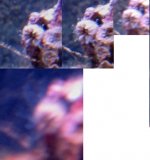A
Anonymous
Guest
The first is an occurrence that I hope isn't a bad thing. On one of my rocks there is a small hole which I have observed what look like small grains of sand getting ejected up into the water. Possibly eggs of some kind?
The second is in the pic. The base is not soft, but felt somewhat hard the last time I did a water change. Whatever it is it has clear tentacles which I have observed grabbing a flake of food as it floated into it. It has yet to move from it's location on the rock.
The second is in the pic. The base is not soft, but felt somewhat hard the last time I did a water change. Whatever it is it has clear tentacles which I have observed grabbing a flake of food as it floated into it. It has yet to move from it's location on the rock.






